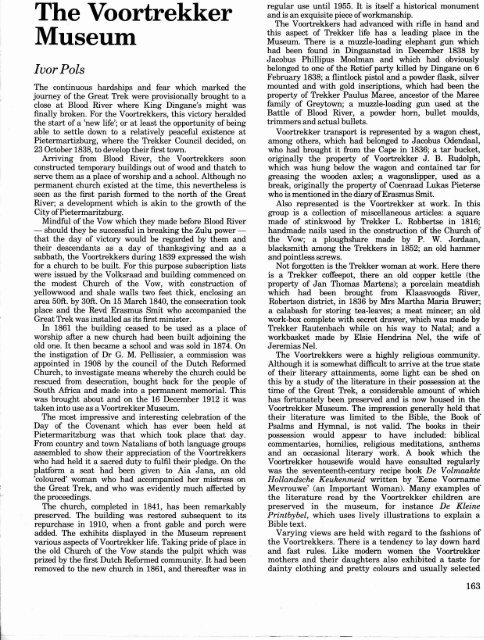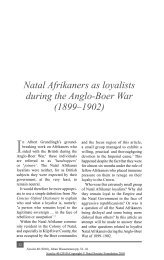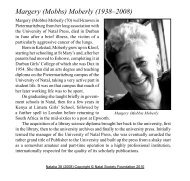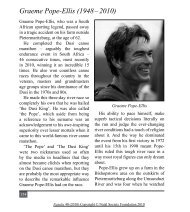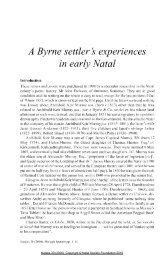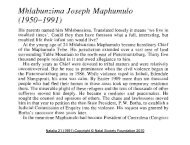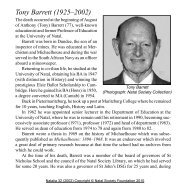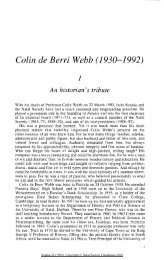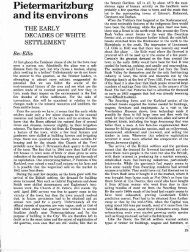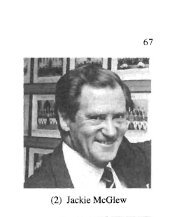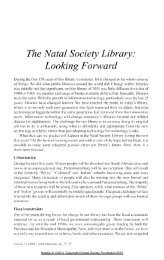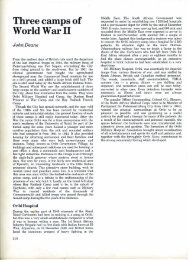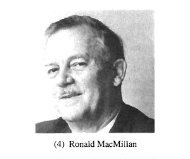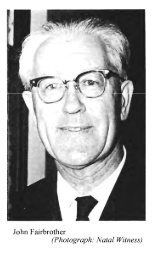The Voortrekker Museum - Pmbhistory.co.za
The Voortrekker Museum - Pmbhistory.co.za
The Voortrekker Museum - Pmbhistory.co.za
You also want an ePaper? Increase the reach of your titles
YUMPU automatically turns print PDFs into web optimized ePapers that Google loves.
<strong>The</strong> <strong>Voortrekker</strong><br />
<strong>Museum</strong><br />
Ivor Pols<br />
<strong>The</strong> <strong>co</strong>ntinuous hardships and fear which marked the<br />
journey of the Great Trek were provisionally brought to a<br />
close at Blood River where King Dingane's might was<br />
finally broken. For the <strong>Voortrekker</strong>s, this victory heralded<br />
the start of a 'new life'; or at least the opportunity of being<br />
able to settle down to a relatively peaceful existence at<br />
Pietermartizburg, where the Trekker Council decided, on<br />
23 October 1838, to develop their first town.<br />
Arriving from Blood River, the <strong>Voortrekker</strong>s soon<br />
<strong>co</strong>nstructed temporary buildings out of wood and thatch to<br />
serve them as a place of worship and a school. Although no<br />
permanent church existed at the time, this nevertheless is<br />
seen as the first parish formed to the north of the Great<br />
River; a development which is akin to the growth of the<br />
City of Pietermaritzburg.<br />
Mindful of the Vow which they made before Blood River<br />
- should they be successful in breaking the Zulu power -<br />
that the day of victory would be regarded by them and<br />
their descendants as a day of thanksgiving and as a<br />
sabbath, the <strong>Voortrekker</strong>s during 1839 expressed the wish<br />
for a church to be built. For this purpose subscription lists<br />
were issued by the Volksraad and building <strong>co</strong>mmenced on<br />
the modest Church of the Vow, with <strong>co</strong>nstruction of<br />
yellowwood and shale walls two feet thick, enclosing an<br />
area 50ft. by 30R. On 15 March 1840, the <strong>co</strong>nsecration took<br />
place and the Revd Erasmus Smit who ac<strong>co</strong>mpanied the<br />
Great Trek was installed as its &st minister.<br />
In 1861 the building ceased to be used as a place of<br />
worship aRer a new church had been built adjoining the<br />
old one. It then became a school and was sold in 1874. On<br />
the instigation of Dr G. M. Pellissier, a <strong>co</strong>mmission was<br />
appointed in 1908 by the <strong>co</strong>uncil of the Dutch Reformed<br />
Church, to investigate means whereby the church <strong>co</strong>uld be<br />
rescued from desecration, bought back for the people of<br />
South Africa and made into a permanent memorial. This<br />
was brought about and on the 16 December 1912 it was<br />
taken into use as a <strong>Voortrekker</strong> <strong>Museum</strong>.<br />
<strong>The</strong> most impressive and interesting celebration of the<br />
Day of the Covenant which has ever been held at<br />
Pietermaritzburg was that which took place that day.<br />
From <strong>co</strong>untry and town Natalians of both language groups<br />
assembled to show their appreciation of the <strong>Voortrekker</strong>s<br />
who had held it a sacred duty to fulfil their pledge. On the<br />
platform a seat had been given to Aia Jana, an old<br />
'<strong>co</strong>loured' woman who had ac<strong>co</strong>mpanied her mistress on<br />
the Great Trek, and who was evidently much affected by<br />
the proceedings.<br />
<strong>The</strong> church, <strong>co</strong>mpleted in 1841, has been remarkably<br />
preserved. <strong>The</strong> building was restored subsequent to its<br />
repurchase in 1910, when a front gable and porch were<br />
added. <strong>The</strong> exhibits displayed in the <strong>Museum</strong> represent<br />
various aspects of <strong>Voortrekker</strong> life. Taking pride of place in<br />
the old Church of the Vow stands the pulpit which was<br />
prized by the first Dutch Reformed <strong>co</strong>mmunity. It had been<br />
removed to the new church in 1861, and thereafter was in<br />
regular use until 1955. It is itself a historical monument<br />
and is an exquisite piece of workmanship.<br />
<strong>The</strong> <strong>Voortrekker</strong>s had advanced with rifle in hand and<br />
this aspect of Trekker life has a leading place in the<br />
<strong>Museum</strong>. <strong>The</strong>re is a muzzle-loading elephant gun which<br />
had been found in Dingaanstad in December 1838 by<br />
Ja<strong>co</strong>bus Phillipus Moolman and which had obviously<br />
belonged to one of the Retief party killed by Dingane on 6<br />
February 1838; a flintlock pistol and a powder flask, silver<br />
mounted and with gold inscriptions, which had been the<br />
property of Trekker Paulus Maree, ancestor of the Maree<br />
family of Greytown; a muzzle-loading gun used at the<br />
Battle of Blood River, a powder horn, bullet moulds,<br />
trimmers and actual bullets.<br />
<strong>Voortrekker</strong> transport is represented by a wagon chest,<br />
among others, which had belonged to Ja<strong>co</strong>bus Odendaal,<br />
who had brought it from the Cape in 1836; a tar bucket,<br />
originally the property of <strong>Voortrekker</strong> J. B. Rudolph,<br />
which was hung below the wagon and <strong>co</strong>ntained tar for<br />
greasing the wooden axles; a wagonslipper, used as a<br />
break, originally the property of Coenraad Lukas Pieterse<br />
who is mentioned in the diary of Erasmus Smit.<br />
Also represented is the <strong>Voortrekker</strong> at work. In this<br />
group is a <strong>co</strong>llection of miscellaneous articles: a square<br />
made of stinkwood by Trekker L. Robbertse in 1816;<br />
handmade nails used in the <strong>co</strong>nstruction of the Church of<br />
the Vow; a ploughshare made by P. W. Jordaan,<br />
blacksmith among the Trekkers in 1852; an old hammer<br />
and pointless screws.<br />
Not forgotten is the Trekker woman at work. Here there<br />
is a Trekker <strong>co</strong>ffeepot, there an old <strong>co</strong>pper kettle (the<br />
property of Jan Tllomas Martens); a porcelain meatdish<br />
which had been brought from Klaasvoogds River,<br />
Robertson district, in 1836 by Mrs Martha Maria Bruwer;<br />
a calabash for storing tea-leaves; a meat mincer; an old<br />
work-box <strong>co</strong>mplete with secret drawer, which was made by<br />
Trekker Rautenbach while on his way to Natal; and a<br />
workbasket made by Elsie Hendrina Nel, the wife of<br />
Jeremias Nel.<br />
<strong>The</strong> <strong>Voortrekker</strong>s were a highly religious <strong>co</strong>mmunity.<br />
Although it is somewhat difficult to arrive at the true state<br />
of their literary attainments, some light can be shed on<br />
this by a study of the literature in their possession at the<br />
time of the Great Trek, a <strong>co</strong>nsiderable amount of which<br />
has fortunately been preserved and is now housed in the<br />
<strong>Voortrekker</strong> <strong>Museum</strong>. <strong>The</strong> impression generally held that<br />
their literature was limited to the Bible, the Book of<br />
Psalms and Hymnal, is not valid. <strong>The</strong> books in their<br />
possession would appear to have included: biblical<br />
<strong>co</strong>mmentaries, homilies, religious meditations, anthems<br />
and an occasional literary work. A book which the<br />
<strong>Voortrekker</strong> housewife would have <strong>co</strong>nsulted regularly<br />
was the seventeenth-century recipe book De Volmaakte<br />
Hollandsche Keukenmeid written by 'Eene Voorname<br />
Mevrouwe' (an Important Woman). Many examples of<br />
the literature read by the <strong>Voortrekker</strong> children are<br />
preserved in the museum, for instance De Kleine<br />
Printbybel, which uses lively illustrations to explain a<br />
Bible text.<br />
Varying views are held with regard to the fashions of<br />
the <strong>Voortrekker</strong>s. <strong>The</strong>re is a tendency to lay down hard<br />
and fast rules. Like modern women the <strong>Voortrekker</strong><br />
mothers and their daughters also exhibited a taste for<br />
dainty clothing and pretty <strong>co</strong>lours and usually selected
material with attractive floral designs. <strong>The</strong> dress<br />
material of the early days shows marked superiority in<br />
quality if <strong>co</strong>mpared with that of the present day. This is<br />
evident if we look at the present state of dresses and<br />
material of the period in the <strong>Voortrekker</strong> <strong>Museum</strong>.<br />
Pieces of bright <strong>co</strong>loured taffeta and satin frocks and<br />
shawls of the same material dating more than a hundred<br />
years back are still in a state of good preservation. <strong>The</strong><br />
dress worn by the first <strong>Voortrekker</strong> woman who arrived<br />
in Natal is on exhibit.<br />
Dresses for daily use were made of floral, checked or<br />
striped <strong>co</strong>tton material, with silk, satin, velvet and brocade<br />
being kept for best. Closely <strong>co</strong>nnected with the dresses<br />
were the aprons which were worn on all occasions. <strong>The</strong><br />
<strong>Voortrekker</strong> women were passionately fond of neckerchiefs<br />
and scarves which served as the only de<strong>co</strong>ration of these<br />
frocks of simple cut. <strong>The</strong>y were pinned together with a<br />
gold, silver or ivory brooch. <strong>The</strong> <strong>Voortrekker</strong> bonnet,<br />
although simple in itself, ranks amongst the most<br />
picturesque and artistic items of <strong>Voortrekker</strong> dress. <strong>The</strong><br />
bonnets still remain as evidence of the skill and artistic<br />
taste of the past generation. No photograph or description<br />
is capable of doing justice to the art displayed in them.<br />
<strong>The</strong> <strong>Voortrekker</strong> men were also fond of fine clothes and<br />
of soft, be<strong>co</strong>ming material. <strong>The</strong> type of trousers worn was<br />
known as flaptrouser. Felt hats with broad brims and flat<br />
crowns were usually worn. Waist<strong>co</strong>ats worn on special<br />
occasions were made of rich satin, silk, velvet and satin<br />
brocade and so on. <strong>The</strong> <strong>Voortrekker</strong> <strong>Museum</strong> has the<br />
wedding waist<strong>co</strong>ats of Sarel Cilliers, Pieter Lafras Uys and<br />
Commandant-General Andries Pretorius. <strong>The</strong>ir ordinary<br />
working clothes were of <strong>co</strong>arser material, such as tweed<br />
and moleskin. <strong>The</strong> men, as well as the women, wore<br />
handmade leather shoes.<br />
<strong>The</strong> <strong>Voortrekker</strong> <strong>Museum</strong> was proclaimed an historical<br />
monument in 1937. During the past six years the<br />
<strong>Voortrekker</strong> <strong>Museum</strong> has undergone vast changes and<br />
greatly expanded.<br />
Under the auspices of the <strong>Voortrekker</strong> <strong>Museum</strong>, many<br />
projects have been undertaken to preserve the <strong>Voortrekker</strong><br />
heritage in Pietermaritzburg and its environs. <strong>The</strong> house<br />
of Andries Pretorius, first double-storey built outside the<br />
Cape Colony, was situated on the farm Welverdiend some<br />
20 kilometres from the City. This house has been<br />
re<strong>co</strong>nstructed adjacent to the <strong>Museum</strong>, using as much of<br />
the original building material as possible. With <strong>Museum</strong><br />
funds and help from many private firms, this project was<br />
<strong>co</strong>mpleted in 1981.<br />
<strong>Voortrekker</strong> House was another addition to the<br />
<strong>Voortrekker</strong> <strong>Museum</strong> <strong>co</strong>mplex. Situated at 333 Boom<br />
Street, this is the oldest double-storey <strong>Voortrekker</strong> house<br />
in Pietermaritzburg, and was probably the first dwelling in<br />
the City to be painted in <strong>co</strong>lour inside (light blue on the<br />
ground floor and pink upstairs). <strong>The</strong> old house, a declared<br />
national monument, was purchased by the <strong>Museum</strong> and<br />
<strong>co</strong>mpletely restored.<br />
<strong>The</strong> <strong>co</strong>mplex was extended in 1984 by the erection in the<br />
<strong>co</strong>urtyard of Andries Pretorius House of a double-storey<br />
building to house a workshop, library and offices. In<br />
addition, negotiations have just been <strong>co</strong>ncluded to<br />
in<strong>co</strong>rporate the huge property of Longmarket Street Girls'<br />
School. A project being planned at the moment is the<br />
restoration of the historical portion of the <strong>Voortrekker</strong><br />
farm Zaaylager on the outskirts of Es<strong>co</strong>urt, which was<br />
saved at the eleventh hour by private citizens.<br />
<strong>The</strong> <strong>Voortrekker</strong> <strong>Museum</strong> was the first in southern<br />
Africa to receive the full accreditation of the South African<br />
<strong>Museum</strong> Association.


